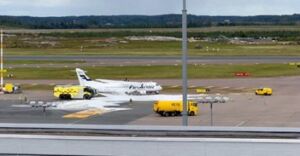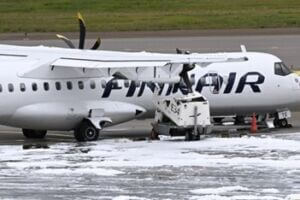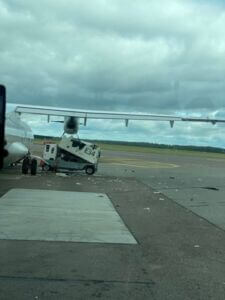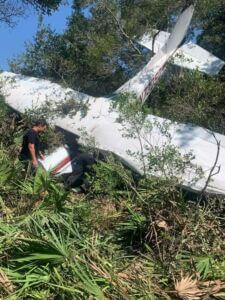We start the new week with these stories...
Be safe out there!
Tom
Accident at Helsinki Airport – eyewitnesses describe a terrifying sight
15 rescue units were called to the scene.
Lauri Silvander
The rescue service received an alert about a major air traffic accident on Vantaa Airport Road at 10:48.
air traffic accident on Vantaa Airport Road at 10:48.
According to the rescue service, the propeller of the aircraft on the ground hit "a device on the ground."
Rescue operations are underway, the rescue service reports. No one has been injured.
The images submitted by an IS reader show a Finnair ATR 72-500 aircraft with the registration number OH-ATE.
Juho Pirhonen, who was on board the plane at the time of the accident, says that the plane was just taking off. The plane jerked forward and hit a grounding device on the ground.
Finnair's communications director confirms to STT that the plane collided with ground power equipment while moving forward after takeoff. The flight, operated by Norra, was canceled due to propeller damage.
Jani Kilpeläinenwatched the rescue operations from the observation deck at Helsinki Airport with his son Oliver, 4. He says that from the front, the left side of the plane is damaged. Pieces of the damaged propeller blade also appeared to have hit the plane's fuselage.
from the observation deck at Helsinki Airport with his son Oliver, 4. He says that from the front, the left side of the plane is damaged. Pieces of the damaged propeller blade also appeared to have hit the plane's fuselage.
Another eyewitness interviewed by IS also says he saw the rescue service arrive at the scene.
– We waited for a while and suddenly people started arriving one by one. The situation was quite calm. The plane was stationary throughout the entire situation.
It took some time for the rescue operation to begin. Incoming aircraft passed by the plane in between.
begin. Incoming aircraft passed by the plane in between.
Then, stairs were lowered from the rear of the plane, allowing passengers to exit the plane.
According to the Flightradar flight tracking service, the plane in question was scheduled to depart on a scheduled flight to Gdansk, Poland, at 10:25 a.m. Flight AY1175 to Gdansk has now been canceled, according to Finavia.
The people on board were transferred back to the terminal. There were 68 people on board at the time of the accident.
IS reporter Akseli Vanhala, who is on site , says that the situation at Helsinki Airport is calm as of noon. According to Vanhala, the rescue service is still on site.
Based on the images, the rescue service is currently removing fuel that leaked from the plane due to the accident. A lot of foam is visible on the ground around the plane.
https://www.is.fi/kotimaa/art-2000011432454.html
Two Injured After Small Plane Crashes Near Space Coast Regional Airport
Author: titusvillemedia
A small aircraft carrying a flight instructor and a student pilot crashed in a wooded area just west of Space Coast Regional Airport on Friday afternoon, according to emergency officials. Both occupants were transported to local hospitals for treatment.
student pilot crashed in a wooded area just west of Space Coast Regional Airport on Friday afternoon, according to emergency officials. Both occupants were transported to local hospitals for treatment.
The Titusville Fire Department reported that a 911 call was received at approximately 2:13 p.m. The call was placed by the occupants of the plane, who reported crashing north of Shepard Drive.
Emergency crews from the Titusville Fire Department, Titusville Police Department, and Brevard County Fire Rescue were immediately dispatched to the scene.
Upon arrival, first responders located the two occupants. According to the official press release, one individual sustained serious injuries, while the second suffered non-life-threatening injuries. Both were transported for medical care.
The scene has been secured, and a federal agency is en route to begin an investigation into the cause of the crash.
Small plane makes emergency landing on San Diego highway
Anna Ashcraft
SAN DIEGO (FOX 5/KUSI) — Drivers on a San Diego highway had to avoid a small plane that landed on the road after an aircraft emergency Saturday afternoon.
Diego highway had to avoid a small plane that landed on the road after an aircraft emergency Saturday afternoon.
The California Highway Patrol (CHP) and Federal Aviation Administration (FAA) are investigating after a small plane landed on I-805 near Carroll Canyon Road in Sorrento Valley in northern San Diego County around 5:30 p.m. Saturday.
CHP reports it appears the plane landed due to mechanical issues.
The flight tracker shows a private plane was heading from the San Diego Montgomery-Gibbs Executive Airport to San Diego Miramar Marine Corps Air Station.
No injuries were reported.
https://www.yahoo.com/news/articles/small-plane-makes-emergency-landing-013502871.html
Frontier Air Plane Damaged After Air Conditioning Hose Gets Sucked Into Engine
by Mateusz Maszczynski
Passengers on board a Frontier Airlines flight from Charlotte to LaGuardia faced a lengthy delay on Saturday after an air conditioning hose got sucked into one of the two engines of the Airbus A320, which was due to operate the flight.
from Charlotte to LaGuardia faced a lengthy delay on Saturday after an air conditioning hose got sucked into one of the two engines of the Airbus A320, which was due to operate the flight.
Frontier flight 3134 had already boarded passengers on Saturday morning when eyewitnesses caught the extraordinary moment that the ground air supply hose was sucked into the engine.
“That engine’s fried, I think,” one passenger said in a video that showed a disintegrated part of the hose spinning around the fan blades of the left-hand engine of the five-year-old aircraft.
Passengers on board a Frontier Airlines flight from Charlotte to LaGuardia faced a lengthy delay on Saturday after an air conditioning hose got sucked into one of the two engines of the Airbus A320, which was due to operate the flight.
Frontier flight 3134 had already boarded passengers on Saturday morning when eyewitnesses caught the extraordinary moment that the ground air supply hose was sucked into the engine.
“That engine’s fried, I think,” one passenger said in a video that showed a disintegrated part of the hose spinning around the fan blades of the left-hand engine of the five-year-old aircraft.
“We’re not getting on this flight… this flight isn’t taking off,” the man says in the video.
According to the Facebook group Flight Secrets Exposed, the aircraft was due to depart Charlotte at 9:55 am on August 16, but the airline eventually decided to deplane everyone back into the terminal while they worked out what to do next.
Unfortunately, any chance of a quick fix was nonexistent, so Frontier had to scramble to find a replacement aircraft to get passengers to New York.
In the end, a new plane couldn’t be sourced until around 7 pm, when the passengers boarded another aircraft, arriving in LaGuardia with a delay of around nine hours.
During the hot summer months, ground power air conditioning units are an absolute essential, pumping cooled air into the plane while the engines are switched off and the aircraft doesn’t have its own air conditioning systems working.
The cooled air is supplied from large hoses that connect to a special port in the underbelly of the aircraft. Sometimes, these hoses are connected to the jetbridge, or in some cases, boxes located close to the aircraft.
As you can imagine, the aircraft has been removed from service for at least the next few days while engineers work out how much damage has been caused to the engine.
Frontier Air Plane Damaged After Air Conditioning Hose Gets Sucked Into Engine
NTSB Final Report: Costruzioni Aeronautiche Tecna P2002 Sierra MKII
As The Main Wheels Touched Down A Wind Gust From The Right Pushed The Airplane Off The Runway
Location: Nacogdoches, Texas Accident Number: CEN25LA145
Date & Time: March 24, 2025, 10:48 Local Registration: N439FJ
Aircraft: Costruzioni Aeronautiche Tecna P2002 Sierra MKII Aircraft Damage: Substantial
Defining Event: Loss of control on ground Injuries: 1 None
Flight Conducted Under: Part 91: General aviation - Personal
Analysis: The pilot reported that the initial leg of the cross-country flight proceeded normally. As he approached the airport to land on the return flight, a right 80° crosswind prevailed. The first two approaches to runway 36 were not stable, and he decided to execute go-arounds. On the third approach, the crosswind was then gusting to 17 knots; however, the approach seemed to be stable, and the pilot continued with the landing. As the main wheels touched down a wind gust from the right pushed the airplane off the runway. The pilot’s efforts to maintain directional control were not successful, and the airplane exited the left side of the runway.
The airplane came to rest in the grass area adjacent to the runway with substantial damage to the firewall and engine mount. The pilot reported no failures or malfunctions that might have contributed to the loss of control. The recorded wind at the time of the accident was 070° at 11 knots.
Probable Cause and Findings: The National Transportation Safety Board determines the probable cause(s) of this accident to be -- The pilot’s failure to maintain directional control while landing with a crosswind.
FMI: www.ntsb.gov
NTSB Final Report: Stinson 108
Contributing To The Accident Was (Pilot's) Impairment From The Effects Of Alcohol Consumption
Location: North Pole, Alaska Accident Number: ANC25LA036
Date & Time: April 25, 2025, 03:00 Local Registration: N9308K
Aircraft: Stinson 108 Aircraft Damage: Substantial
Defining Event: Collision with terr/obj (non-CFIT) Injuries: 1 Minor
Flight Conducted Under: Part 91: General aviation - Personal
Analysis: The pilot departed an unknown airstrip and made an emergency landing at a US Army airfield. The left wing strut was substantially damaged and consistent with an impact with a tree. The pilot was uncooperative with first responders and smelled of alcohol and appeared to be under the influence. A police officer found an open container of alcohol in the airplane and transported the pilot to the hospital.
Probable Cause and Findings: The National Transportation Safety Board determines the probable cause(s) of this accident to be -- The pilot's failure to maintain obstacle clearance which resulted in an in-flight collision with a tree.
Contributing to the accident was his impairment from the effects of alcohol consumption.
FMI: www.ntsb.gov
NTSB Prelim: Robinson Helicopter Co R66
Helicopter Was About 5 To 10 Ft Above The Corn When, During A Turn, The Turbine Engine Flamed Out
Location: Maynard, IA Accident Number: CEN25LA277
Date & Time: July 22, 2025, 14:00 Local Registration: N88911
Aircraft: Robinson Helicopter Co R66 Injuries: 1 None
Flight Conducted Under: Part 137: Agricultural
On July 22, 2025, about 1400 central daylight time, a Robinson Helicopter Company R66 helicopter, N88911, was substantially damaged when it was involved in an accident near Maynard, Iowa. The pilot was uninjured. The helicopter was operated under Title 14 Code of Federal Regulations as a Part 137 aerial application flight.
The pilot stated that he had been conducting spray operations for about 50 minutes. The helicopter was about 5 to 10 ft above the corn when, during a turn, the turbine engine flamed out. He stated that he immediately lowered the collective and applied aft cyclic to gain altitude.
The pilot then executed a forced landing in the corn field, which resulted in the separation of the helicopter’s tailboom.
The helicopter was retained for further examination.
FMI: www.ntsb.gov

Today in History
52 Years ago today: On 18 August 1973 An Aeroflot Antonov An-24, crashed shortly after takeoff from Baku Airport, Azerbaijan, killing 56 occupants; 8 survived the accident.
| Date: | Saturday 18 August 1973 |
| Time: | 18:51 |
| Type: | Antonov An-24B |
| Owner/operator: | Aeroflot / Azerbaijan |
| Registration: | CCCP-46435 |
| MSN: | 87304305 |
| Year of manufacture: | 1968 |
| Total airframe hrs: | 7374 hours |
| Cycles: | 5502 flights |
| Engine model: | Ivchenko AI-24 |
| Fatalities: | Fatalities: 56 / Occupants: 64 |
| Other fatalities: | 0 |
| Aircraft damage: | Destroyed, written off |
| Category: | Accident |
| Location: | 4,3 km E of Baku-Bina International Airport (BAK) - Azerbaijan |
| Phase: | Approach |
| Nature: | Passenger - Scheduled |
| Departure airport: | Baku-Bina International Airport (BAK/UBBB) |
| Destination airport: | Shevchenko Airport |
| Confidence Rating: | Information is only available from news, social media or unofficial sources |
Narrative:
An Aeroflot Antonov An-24, crashed shortly after takeoff from Baku Airport, Azerbaijan, killing 56 occupants; 8 survived the accident.
An uncontained no. 1 engine failure on takeoff from Baku forced the crew to return to the airport. While manoeuvering, the left had wing tip struck a cable at an oil rig at Neftyanyye Kamni oilfield. The aircraft descended until it struck a pipe line 161 m further on. It struck another pipe line and went over an oil waste pits before coming to rest. A fire erupted.
